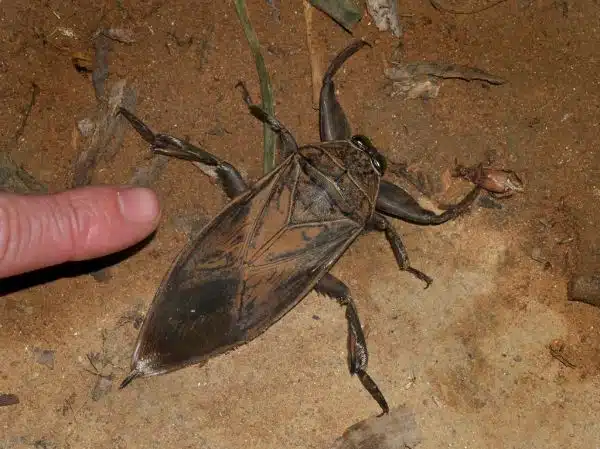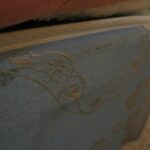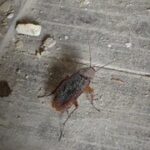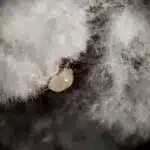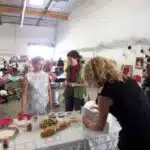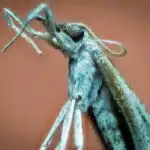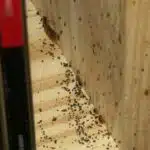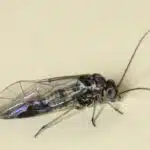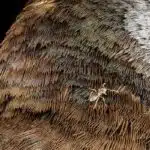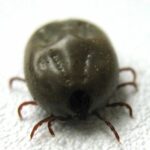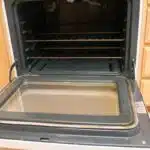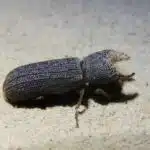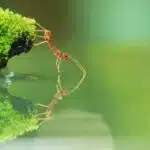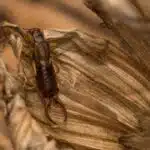Water bugs are a common household pest that can cause significant discomfort and distress for homeowners. These insects are often mistaken for cockroaches due to their similar appearance, but water bugs differ in their aquatic habits and preference for living near sources of water. They can be particularly challenging to eliminate from homes, as they are resilient and adapt quickly to changes in their environment.
As a pest control expert, I have encountered many cases of homes infested with water bugs. In this article, I will provide valuable insights on how to get rid of these pests effectively. From identifying the signs of an infestation to implementing preventative measures, homeowners will learn everything they need to know about preventing water bug infestations and maintaining a clean and safe home environment. With my expert guidance, readers will gain the knowledge and tools necessary to tackle even the most stubborn water bug problems.
Understanding Water Bugs: What Are They And Why Are They A Problem?
Water bugs, also known as roaches or palmetto bugs, are a common household pest that can wreak havoc on your home. These insects are typically found in damp, dark areas such as basements, bathrooms, and kitchens. They thrive in moist environments and are often attracted to standing water.
Water bug habits include seeking out sources of food and water, which means they can contaminate surfaces and spread disease. They are also known for their ability to survive extreme temperatures and harsh conditions. If left unchecked, water bugs can quickly multiply and infest your home, making it difficult to control their population.
The dangers of water bug infestations go beyond just being a nuisance. These pests can trigger allergies and asthma attacks in sensitive individuals. They can also carry bacteria that cause diseases like salmonella and E.coli. It is crucial to take prompt action if you suspect a water bug infestation in your home to prevent the spread of harmful pathogens.
Identifying Signs Of A Water Bug Infestation
- Unusual odors may be a sign of a water bug infestation, as water bugs can emit a musky, musty smell.
- Unusual stains and wet spots on walls and floors could be caused by water bugs and their excrement.
- Increased insect activity and visible water bugs are other signs of water bug infestations.
- Nests, egg sacs, shed skin, and muddy footprints may be seen around areas where water bugs are present.
Unusual Smells
Eliminating odors is an essential step in getting rid of water bugs in your home. Water bugs are attracted to moist areas, and they thrive in environments with a high level of humidity. These pests emit a strong, unpleasant odor that can linger for days or even weeks. If you detect an unusual smell in your home, it could be a sign of a water bug infestation.
To eliminate odors caused by water bugs, it’s crucial to identify the source of the problem. Check for leaks in pipes, faucets, and appliances that use water. Also, inspect the area around sinks, bathtubs, and toilets for any signs of moisture. Once you’ve identified the source of the problem, fix it immediately. Use a dehumidifier to reduce the level of humidity in your home and prevent water bugs from coming back.
Detecting moisture is also important when dealing with water bug infestations. Water bugs require moisture to survive and reproduce. They are often found near sources of water such as sinks, bathtubs, and toilets. If you notice any wet spots or damp areas in your home, it could be a sign that you have a water bug infestation. Use a moisture meter to detect any hidden sources of moisture in your walls or floors. By detecting and eliminating sources of moisture, you can prevent future infestations and keep your home free from these pests.
In conclusion, eliminating odors and detecting moisture are critical steps in getting rid of water bugs in your home. If you suspect that you have a water bug infestation, act quickly to identify and fix the problem before it gets out of hand. With proper care and attention to detail, you can get rid of these pests once and for all!
Strange Sounds
Recognizing patterns is a vital skill when identifying signs of a water bug infestation. While visible sightings of these pests are one obvious sign, strange sounds can also indicate their presence. Water bugs are known to make clicking or tapping noises as they move around in search of food and mates. If you hear these sounds coming from your walls, floors or other areas of your home, it’s possible that you have a water bug infestation.
However, strange sounds alone may not always be indicative of a water bug infestation. Other pests such as mice and rats can also make similar noises. Therefore, it’s essential to seek professional help from pest control experts who can identify the specific type of pest causing the noise. Professionals will use advanced tools and techniques to detect and eliminate the source of the problem effectively.
In conclusion, recognizing patterns such as strange sounds is critical when identifying signs of a water bug infestation. However, seeking professional help is equally important to accurately diagnose and treat the problem. With expert guidance and proper prevention measures, you can keep your home free from water bugs and other pests for good!
Prevention Techniques: Keeping Water Bugs Out Of Your Home
Prevention techniques are key to keeping water bugs out of your home. DIY prevention methods can be effective in deterring these pests from entering your living space. Begin by sealing any cracks or crevices where water bugs may enter, especially around windows and doors. Use caulk to fill gaps and ensure that screens are properly fitted and free of holes. Eliminating potential entry points for water bugs is a crucial step in preventing an infestation.
Professional exclusion techniques can also be used to prevent water bug infestations. Hiring a pest control expert can ensure that your home is properly sealed against any potential pests, including water bugs. Professionals are equipped with specialized equipment and knowledge to identify areas of the home that may be vulnerable to invasion by these insects. By taking proactive measures, you can protect your home from the damaging effects of a water bug infestation.
Preventing water bug infestations requires diligence in maintaining proper sanitation practices within the home. In addition to sealing up entry points, it is important to eliminate attractants such as standing water sources or food debris. By removing these attractants, you can reduce the likelihood of a water bug infestation occurring in your home. Remember, prevention is key when it comes to managing pests in the household!
Sanitation Practices: Removing Water Bug Attractants
As a pest control expert, one of the most important aspects of water bug prevention is proper sanitation practices. Deep cleaning your home regularly is crucial in eliminating potential water bug attractants. This includes sweeping and mopping floors, wiping down countertops, and washing dishes promptly. These efforts will remove any leftover food particles that could attract water bugs.
Proper food storage is also key in preventing water bugs from invading your home. Food should be stored in sealed containers to prevent easy access for pests. Any open packages or bags of food should be tightly sealed or placed into sealable containers as soon as possible. Additionally, keep pet food stored in airtight containers and wipe down their feeding areas daily to eliminate any crumbs or spills that could attract pests.
In addition to deep cleaning and proper food storage, it’s essential to remove any sources of moisture in your home. Leaks should be fixed immediately to prevent standing water from accumulating. Damp areas such as bathrooms and basements should be thoroughly dried out to eliminate potential breeding grounds for water bugs. By taking these steps, you can significantly reduce the risk of a water bug infestation in your home.
Transition: While sanitation practices are critical in preventing water bugs from invading your home, sometimes natural remedies can also help eliminate them without the use of toxic chemicals. Let’s explore some non-toxic methods that you can use to get rid of these pesky insects.
Natural Remedies: Using Non-Toxic Methods To Eliminate Water Bugs
- DIY traps, such as using a jar filled with soapy water, can be an effective way to trap and eliminate water bugs.
- Natural repellents, such as essential oils, can be used to create a barrier that will help keep water bugs from entering your home.
- Regularly cleaning areas of your home, such as bathrooms and kitchens, can help reduce the amount of water bugs in your home.
- Keeping areas of your home free of debris and clutter can also help reduce the presence of water bugs.
- Regularly inspecting the perimeter of your home for any potential entryways can help reduce the chances of water bugs entering your home.
- Applying caulk or foam sealant to any potential entryways can help to keep water bugs from entering your home.
Diy Traps
Water bugs can be a nuisance in any home, but there are natural remedies that can help eliminate them without the use of toxic chemicals. One effective method is making DIY traps with homemade solutions.
To create a DIY bait for water bugs, mix equal parts sugar and baking soda and place it in areas where water bugs are frequently seen. The sugar attracts the bugs while the baking soda reacts with their digestive system, killing them. Another option is to use a mixture of borax and sugar in the same way.
Homemade solutions can also be used as bait for water bug traps. A mixture of equal parts vinegar and water can be sprayed directly on the bugs or around areas where they frequent to deter them from coming back. Additionally, a mixture of dish soap and hot water can be used to kill any bugs that come into contact with it. By using these simple DIY methods, homeowners can effectively eliminate water bugs from their homes without resorting to harmful chemicals.
Natural Repellents
Natural repellents are an effective way to keep water bugs away from homes without resorting to toxic chemicals. These repellents can be made at home using common household items and can be just as effective as store-bought products. In this subtopic, we will discuss how to make natural repellents using DIY solutions.
One of the most effective natural repellents is a mixture of essential oils and water. Peppermint oil, lavender oil, and tea tree oil are all great options for repelling water bugs. Simply mix a few drops of each oil with water in a spray bottle and apply it in areas where water bugs are frequently seen. This mixture not only repels water bugs but also leaves a pleasant scent in the air.
Another natural repellent that works well against water bugs is diatomaceous earth (DE). DE is a fine powder made from fossilized algae and other microorganisms. When sprinkled around areas where water bugs frequent, DE dries out their exoskeletons, ultimately killing them. DE is safe to use around pets and humans but should be handled with care as it can cause irritation if inhaled. By utilizing these natural repellents, homeowners can effectively keep their homes free from pesky water bugs without exposing themselves or their families to harmful chemicals commonly found in commercial pesticides.
Cleaning Solutions
As a pest control expert, I highly recommend using natural remedies to eliminate water bugs in homes. While natural repellents are effective, it is also important to keep the home clean and free from food debris and standing water. DIY cleaning solutions using natural ingredients can help prevent water bugs from infesting the home.
One of the easiest cleaning solutions is a mixture of vinegar and water. Vinegar is a natural disinfectant that also repels insects, including water bugs. Simply mix equal parts vinegar and water and use it to wipe down countertops, floors, and other surfaces where water bugs may be present. Additionally, regularly sweeping and mopping floors can help remove any potential hiding places or food sources for these pests.
Another effective cleaning solution is baking soda combined with essential oils such as peppermint or tea tree oil. Baking soda acts as a scouring agent that helps remove grease and grime while the essential oils provide a fresh scent and repel insects. To make this cleaning solution, mix 1/4 cup of baking soda with a few drops of essential oil and enough water to make a paste. Apply the paste to surfaces like sinks, stovetops, and oven hoods before scrubbing with a sponge or brush.
By incorporating these DIY cleaning solutions into regular home maintenance routines, homeowners can not only maintain cleanliness but also help prevent infestations by naturally repelling water bugs without resorting to toxic chemicals. It’s important to remember that prevention is key in keeping pests at bay, so maintaining good hygiene practices is crucial in maintaining a pest-free home environment.
Chemical Treatments: Using Insecticides To Kill Water Bugs
Now that we have explored natural remedies for eliminating water bugs, let us discuss the use of chemical treatments to eradicate these pests. While DIY alternatives may provide a temporary solution, they may not always be effective in completely eliminating the infestation. Insecticides can offer a more permanent solution, but it is essential to follow safety precautions when handling them.
When using insecticides, it is crucial to read and follow the label instructions carefully. Most insecticides contain toxic chemicals that can harm humans and pets if not used correctly. It is recommended to wear protective clothing such as gloves, goggles, and a mask when applying insecticides. Additionally, ensure proper ventilation in the treated area by opening windows and doors while wearing protective gear.
Before resorting to chemical treatments, it is best to exhaust all other options first. However, if you choose to use insecticides, make sure to handle them with care and follow safety precautions diligently. By doing so, you can eliminate water bugs from your home effectively.
Moving forward into our final section on hiring a professional exterminator: when to call in the experts, we will explore situations where DIY methods may not be enough and why consulting an expert pest control service could be necessary for complete eradication of water bugs from your home.
Hiring A Professional Exterminator: When To Call In The Experts
Just like a surgeon with his scalpel, a professional exterminator is the specialist who can effectively eliminate water bugs in your home. Similar to how it takes years of study and training before one becomes a licensed practitioner, an expert pest control operator has undergone rigorous training to attain their certification. With the appropriate knowledge and equipment, they can identify the root cause of your water bug infestation and use the most effective strategies to eradicate them.
The cost of hiring an exterminator may vary depending on several factors such as the level of infestation, location, and type of treatment needed. However, compared to DIY methods for water bug control that may require multiple attempts or may not be successful at all, hiring a professional exterminator could save you money in the long run. It is also important to note that professional pest control companies offer warranties and follow-up visits to ensure that water bugs are completely eliminated from your home.
If you have tried DIY methods but still find yourself struggling with these pests, it might be time to call in the experts. Remember that attempting to solve the problem on your own can sometimes worsen the situation. Hiring a professional exterminator can help you get rid of these pests quickly and efficiently without causing harm to your home or family. In the next section, we will discuss how inspecting your home thoroughly can help prevent future infestations.
Inspecting Your Home: Where To Look For Water Bugs
- In bathrooms, it is important to inspect places that may accumulate water, such as around the tub, sink, and shower, as these areas are possible entry points for waterbugs.
- In kitchens, waterbugs are likely to be found near the sink, refrigerator, and dishwasher.
- In basements, waterbugs can be found in areas that may contain water, such as around water heaters, dehumidifiers, and washing machines.
- Additionally, waterbugs can enter through small cracks and crevices in the walls or floors, so these should also be inspected for signs of infestation.
- In general, it is important to inspect the entire home for waterbugs, as they are quite mobile and can be found in many different areas.
- If waterbugs are found, it is important to take the necessary steps to remove them and prevent future infestations.
Bathrooms
Water bugs can be a nuisance in any home, and the bathroom is no exception. These pests are attracted to water, making the bathroom an ideal environment for them to thrive. To prevent water bugs from infesting your bathroom, it’s important to inspect your home regularly and take preventative measures such as waterproofing floors and cleaning grout.
Waterproofing floors is a crucial step in preventing water bugs from entering your bathroom. When moisture seeps through cracks in the floor, it creates a breeding ground for these pests. By applying a waterproofing sealant, you can create an impenetrable barrier that keeps water bugs at bay. It’s important to note that this should be done by a professional to ensure proper application.
Another important step in preventing water bug infestations is cleaning grout on a regular basis. Grout is porous and can absorb moisture, providing an ideal habitat for these pests. By keeping the grout clean and dry, you can eliminate their food source and discourage them from taking up residence in your bathroom. A mixture of vinegar and baking soda is an effective natural solution for cleaning grout.
In conclusion, preventing water bug infestations in your bathroom requires regular inspections and preventative measures such as waterproofing floors and cleaning grout. By taking these steps, you can keep your home free of these pesky pests and maintain a healthy living environment for you and your family.
Kitchen
As a pest control expert, it’s important to inspect your home regularly for any signs of water bug infestations. While the bathroom is a common area for these pests, they can also be found in other areas such as the kitchen. Kitchen renovation or organizing tips can help prevent water bugs from entering your home and wreaking havoc on your living space.
One way to prevent water bugs from infesting your kitchen is by keeping it clean and organized. These pests are attracted to crumbs and food debris, so it’s important to wipe down surfaces and sweep floors regularly. Additionally, storing food in airtight containers can help eliminate their food source and discourage them from taking up residence in your kitchen.
Another important step is to seal any cracks or holes in your kitchen walls or floors. Water bugs can enter through even the smallest openings, so it’s crucial to address any potential entry points. Kitchen renovation projects that involve updating tiles or installing new flooring can also help prevent water bugs from finding their way into your home. By taking these preventative measures, you can keep your kitchen free of water bugs and maintain a hygienic living environment for you and your family.
Basements
As a pest control expert, it’s crucial to inspect your home regularly for any signs of water bug infestations. These pests can be found in various areas of your home, including the basement. While basements are typically damp and dark, they can provide the ideal environment for water bugs to thrive. Therefore, it’s important to take preventative measures such as basement waterproofing and using dehumidifiers to keep these pests at bay.
Basement waterproofing is an essential step in preventing water bugs from invading your living space. This process involves sealing any cracks or holes in your basement walls or floors to prevent moisture from seeping into your home. By eliminating excess moisture, you can make it less hospitable for water bugs and other pests that thrive in damp environments.
Another effective way to prevent water bugs from infesting your basement is by using dehumidifiers. Dehumidifiers help regulate the humidity levels in your basement by removing excess moisture from the air. This not only helps prevent water bugs from taking up residence but also helps eliminate musty odors and other allergens associated with damp environments.
In conclusion, keeping a clean and organized kitchen is just one aspect of preventing water bug infestations in your home. As a pest control expert, it’s important to inspect other areas of your living space such as the basement for signs of these pests. By taking preventative measures such as basement waterproofing and using dehumidifiers, you can create a less hospitable environment for water bugs and maintain a hygienic living environment for you and your family.
Understanding Water Bug Behavior: How They Move And Reproduce
Water bugs, also known as cockroaches, are a common household pest that can be quite difficult to eradicate. Understanding their behavior is key to effectively controlling them. Water bugs have a unique anatomy that allows them to thrive in moist environments. Their bodies are covered in a waxy coating that repels water and helps them move quickly across surfaces.
Water bugs have a distinct movement pattern that makes them difficult to catch. They are fast runners and expert climbers, which allows them to navigate through tight spaces and climb up walls and ceilings. In addition, they have the ability to fly short distances, which makes it easy for them to escape when threatened. These behaviors make water bugs highly adaptable creatures that can survive in almost any environment.
In order to effectively control water bug populations in your home, it is important to understand their behavior patterns. By knowing how they move and reproduce, you can take steps to prevent infestations from occurring in the first place. In the subsequent section, we will explore the life cycle of water bugs and discuss their growth stages in more detail. Understanding these stages is crucial for developing an effective pest control plan that targets all aspects of their development cycle.
Water Bug Life Cycle: Understanding Their Growth Stages
Water bugs are aquatic insects that belong to the same family as cockroaches. These pests have a broad, flattened body with a shiny appearance and are usually brown in color. Understanding water bug anatomy is essential to curb their growth and prevent future infestations. Their bodies consist of three segments, including the head, thorax, and abdomen. Water bugs also have two pairs of wings which they use to fly or glide over water surfaces.
Water bugs prefer warm and humid environments, making them more common in areas with high moisture levels such as basements, bathrooms, kitchens, and damp crawl spaces. They can be found in slow-moving streams, ponds, and other still waters where they feed on small fish or other insects. Water bug habitat preferences vary depending on the species of the insect.
To control water bug infestations effectively, it’s crucial to understand their life cycle stages. The life cycle of a typical water bug consists of three stages: egg stage, nymph stage and adult stage. During the egg phase, female water bugs deposit eggs in shallow waters where they hatch into nymphs after about two weeks. Nymphs resemble miniature adults but lack wings until they reach maturity. They continue to molt several times before reaching adulthood and reproducing.
- Water bugs are attracted to light sources at night.
- Removing standing water from around your home can reduce their habitat.
- Regular cleaning of sinks and drains can help prevent infestation.
- Using screens on windows can limit their entry points.
- Chemical pest control treatments can be effective for eliminating water bug populations.
Understanding the different growth stages of a water bug is crucial when trying to get rid of them from your home or business effectively. In the next section, we will explore common species of water bugs: knowing your enemy. By identifying specific types of water bugs commonly found in homes or businesses near you, you can better equip yourself with knowledge on how best to eliminate them.
Common Species Of Water Bugs: Knowing Your Enemy
Water bugs are aquatic insects that thrive in damp environments and can be found in various bodies of water including lakes, ponds, and even sewers. They belong to the Hemiptera order of insects, which means they have piercing-sucking mouthparts used to feed on other small aquatic creatures. In homes, they can easily find their way through drains or plumbing leaks, making them a common household pest.
Identifying water bugs is crucial in determining the best method for control. There are several species of water bugs, with the most common being Giant Water Bugs (Belostomatidae), Water Scorpions (Nepidae), and Toe-Biters (Corixidae). Each species has unique characteristics that distinguish them from one another. For instance, Giant Water Bugs have a flattened oval shape body with a pointed head while Water Scorpions have long slender legs resembling those of scorpions.
Water bug habitats vary according to the species. Some prefer clear waters with vegetation while others prefer dark murky waters such as sewers or drainage systems. Identifying these habitats can help in managing infestations. Additionally, identifying water bug eggs can also aid in control measures as it helps to locate breeding sites. Eggs are often laid on plants or rocks near aquatic environments and appear as small clusters resembling bubbles.
Understanding the different types of water bugs and their habitats is crucial in developing an effective control strategy. Proper identification enables one to choose the best method for eradication thus minimizing damage caused by these pests. However, controlling water bugs is not only about eradicating them but also preventing future infestations by eliminating conducive conditions such as dampness and moisture around homes; this will be discussed further in the subsequent section about health risks associated with water bugs: protecting your family.
Health Risks Associated With Water Bugs: Protecting Your Family
Water bugs, also known as cockroaches, are not only unpleasant to look at but also pose serious health risks to humans. According to a recent study conducted by the World Health Organization (WHO), cockroaches are known carriers of several diseases, including salmonella, typhoid fever, and cholera. This is alarming considering that the presence of water bugs in your home can put your family’s health at risk.
Protective measures must be taken to prevent water bugs from invading your home. First and foremost, it is crucial to maintain a clean living environment. Cockroaches thrive in dirty and cluttered spaces, so keeping your home clean and tidy will reduce their chances of survival. Additionally, sealing cracks around windows and doors with silicone caulk can prevent them from entering your home.
The health concerns associated with water bugs should not be taken lightly. By implementing protective measures such as regular cleaning and sealing entry points into your home, you can significantly reduce the risk of infestation. In the next section, we will discuss tips for maintaining a water bug-free home for long-term prevention.
Maintaining A Water Bug-Free Home: Tips For Long-Term Prevention
- Prevention is the best way to keep water bugs out of the home.
- Sealing any gaps or cracks on the exterior of the building can help to keep water bugs from entering.
- Checking for any persistent moisture around the exterior of the building can help to identify potential entry points for water bugs.
- Keeping the interior of the home clean is also important to keep water bugs from being attracted to the space.
- Regularly cleaning and vacuuming the interior of the home can help to eliminate any food sources that may attract water bugs.
- Taking steps to reduce moisture and humidity in the home can also help to reduce the number of water bugs that may enter the home.
Seal Gaps
Are you tired of waking up to water bugs crawling around your home? One effective way to prevent these pests from entering your living space is by sealing gaps. Water bugs often come in through small openings, such as cracks and crevices in walls or floors, so taking the time to seal these gaps can make a big difference.
To effectively seal gaps and prevent entry, start by identifying potential entry points. Check for any cracks or holes in the walls or floors, especially near pipes or other areas where moisture may be present. Once you have identified these areas, use caulk or foam insulation to fill in the gaps. This will help keep water bugs out and also reduce the amount of moisture that can enter your home.
Remember to regularly inspect your home for new gaps or openings that may have formed over time. By sealing gaps and preventing entry, you can create a barrier between your living space and water bugs. With consistent efforts, you can enjoy a bug-free home for years to come.
Check For Moisture
To maintain a water bug-free home, it’s important to check for moisture regularly. Water bugs thrive in damp environments, so any areas of your home that are consistently moist are likely to attract them. One way to prevent excess moisture is by checking for leaks around your home. Leaks can occur in pipes, faucets, and even roofs, so it’s important to inspect these areas frequently.
If you do find any leaks, repair them as soon as possible. Not only will this help prevent water bugs from entering your home, but it will also save you money on your water bill. In addition to fixing leaks, using a dehumidifier can also help reduce the amount of moisture in the air. This is especially important in areas such as basements or crawl spaces where humidity levels tend to be higher.
By checking for moisture and taking steps to reduce it, you can create an environment that is less appealing to water bugs. This will not only help keep these pests out of your living space but also improve the overall quality of air in your home. Remember to stay vigilant and continue monitoring for any signs of excess moisture or potential entry points for pests. With consistent efforts and attention to detail, you can enjoy a bug-free home for years to come while serving others who may need pest control advice.
Clean Regularly
Another important step in maintaining a water bug-free home is regular cleaning. Water bugs are attracted to food residue and crumbs left behind, so it’s crucial to keep your home clean and tidy. Regular cleaning will help eliminate potential food sources for pests and reduce the likelihood of an infestation.
In addition to regular cleaning, incorporating deep cleaning techniques can also be beneficial in preventing water bugs from entering your home. This includes vacuuming carpets and upholstery, wiping down surfaces with disinfectant, and mopping floors regularly. By removing dirt, debris, and other potential attractants, you can create an environment that is less appealing to pests.
It’s important to note that even with regular cleaning practices, some areas of your home may still require extra attention. For example, basements or crawl spaces can be particularly vulnerable to moisture buildup and should be inspected regularly. By incorporating both regular and deep cleaning practices into your routine, you can help maintain a pest-free home for years to come while serving others who may need pest control advice.
Dealing With Re-Infestations: What To Do If Water Bugs Return
Maintaining a Water Bug-Free Home: Tips for Long-Term Prevention is an effective approach to avoid water bug infestations. However, it is not always possible to prevent an infestation from happening. When it comes to dealing with re-infestations, there are two options: DIY prevention or professional treatment.
DIY prevention involves identifying the source of the infestation and removing it. Common mistakes people make when trying to deal with water bugs include using pesticides without proper knowledge, leaving out food and water sources, and neglecting to seal entry points. To avoid re-infestation, it is important to address these issues properly.
If the situation becomes overwhelming or if the infestation is severe, professional treatment may be necessary. Pest control experts can identify the severity of the problem and provide appropriate solutions tailored to your specific needs. They have access to professional-grade products that are more effective than over-the-counter solutions.
In conclusion, preventing water bug infestations requires consistent effort in maintaining a clean and dry environment. However, if re-infestation occurs despite your efforts, DIY prevention or professional treatment can help you get rid of them for good. Our next section will answer frequently asked questions about water bugs and provide additional tips on how to deal with them effectively.
Frequently Asked Questions: Answering Common Concerns About Water Bugs
FAQs about Water Bug Control
Water bugs can be a nuisance in any home, and it is common for homeowners to have questions regarding their control. Below are some frequently asked questions about water bug control:
Q: What are water bugs? A: Water bugs are aquatic insects that can be found in bodies of water such as lakes, ponds, and streams. They are attracted to damp environments, and when they find their way into homes, they can cause problems.
Q: How do I know if I have water bugs in my home? A: Signs of a water bug infestation include sightings of the insects themselves, as well as small droppings or shed skins. You may also notice an unpleasant smell or hear a rustling sound coming from areas where the bugs are present.
Q: How can I effectively remove water bugs from my home? A: There are several tips for effective water bug removal, including keeping your home clean and dry, sealing all cracks and crevices in walls and floors, using insecticides specifically designed for water bug control, and seeking professional pest control services if necessary.
Tips for Effective Water Bug Removal:
- Keep your home clean and dry
- Seal all cracks and crevices in walls and floors
- Use insecticides specifically designed for water bug control
- Seek professional pest control services if necessary
As a pest control expert, it is important to address the concerns of homeowners who may be dealing with a water bug infestation. By following these tips for effective removal and seeking professional help when needed, you can successfully eliminate these pests from your home. Remember to take preventative measures to avoid future infestations by keeping your living space clean and dry.
Conclusion
Water bugs can be a pesky and unpleasant problem in any home. As pest control experts, we understand the importance of identifying signs of infestations early on to prevent serious issues down the line. By implementing prevention techniques such as sealing cracks and crevices, removing standing water sources, and practicing good sanitation habits, homeowners can reduce the likelihood of water bug infestations.
It is interesting to note that according to a study by the National Pest Management Association, 56% of homeowners consider pests to be their primary concern when it comes to household maintenance. This highlights the importance of being proactive in preventing water bug infestations and other pest problems. Natural remedies such as diatomaceous earth or essential oils can also be effective in eliminating water bugs without using harmful chemicals.
Ultimately, maintaining a water bug-free home requires diligence and consistency in implementing preventative measures. By understanding the risks associated with water bugs and taking proactive steps to prevent infestations, homeowners can protect their families from potential health hazards and ensure long-term pest control success.
Image Credits
- “Giant water bug (Belostomatidae), Vohimana reserve, Madagascar” by Frank.Vassen (featured)

